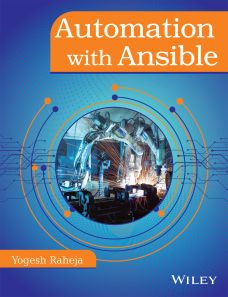Automation with Ansible
ISBN: 9788126570331
268 pages
eBook also available for institutional users
For more information write to us at: acadmktg@wiley.com

Description
Automation with Ansible is based on a Technical Tool called Ansible for IT Automation. Ansible is a very easy to use IT Automation Configuration Management and Orchestration Software majorly used by DevOps and System Administrators. This tool is used to automate Application Deployments, Infrastructure Provisioning and whole Infrastructure environment for configuration and management with ease. Any application used in Information Technology can be configured, maintained, upgraded in large scale environments in minutes with almost no human efforts.
Preface
Acknowledgments
About the Author
Chapter 1 Introduction to Configuration Management with Ansible
1.1 Ansible: An Introduction
1.2 Current IT Automation State
1.3 Configuration Management
1.4 Ansible History
1.5 Introducing Ansible
1.6 How Ansible Works
1.7 Dataflow
Chapter 2 Understanding of Ansible Framework
2.1 Case Study
2.2 Ansible Way of Configuration Management
2.3 Infrastructure as a Code (IaC)
2.4 Idempotency
2.5 Ansible Terminology
Chapter 3 Ansible Deployment
3.1 Pre-Requisites for Controller Node
3.2 Installation and Configuration
3.3 Ansible Configuration File
3.4 Pre-Requisites for Managed Node
3.5 Ansible Inventory
3.6 Ansible Communication
3.7 Ansible Architecture
Chapter 4 Ad-Hoc Execution with Ansible
4.1 Ansible Modules
4.2 Ad-Hoc Remote Executions
4.3 Ansible Commands
4.4 Connections and Privilege Escalations
Chapter 5 Ansible Playbooks
5.1 YAML Structure
5.2 Ansible Playbooks
5.3 Playbooks Structure
5.4 Playbooks Syntax Checks
5.5 Playbooks Smoke Test
5.6 Playbooks Real-Time Run
5.7 Playbook Examples 1
Chapter 6 Variables in Ansible
6.1 Ansible Variables: An Introduction
6.1.1 Defining Variable in Ansible Code
6.2 Use Cases
6.3 Ansible Facts
6.4 Facts in Playbooks
6.5 Disabling Facts
Chapter 7 Conditionals, Loops and Handlers
7.1 Conditionals in Ansible
7.2 Loops in Ansible
7.3 Handlers in Ansible
Chapter 8 Ansible Roles
8.1 Introduction
8.2 Directory Structure
8.3 Role Creation
8.4 Include and Dependency Management
Chapter 9 Ansible Vault
9.1 Introduction
9.2 Real-Time Example with Ansible Vault
Chapter 10 Ansible Galaxy
10.1 Ansible Galaxy: An Overview
10.2 Real-Time Example with Ansible Galaxy
Chapter 11 Ansible Playbook Optimization
11.1 Copy and Fetch Modules
11.2 Facts
11.3 Forks
11.4 Serial & Max_Fail_Percentage
11.5 Asynchronous Action and Pooling
11.6 Delegate
11.7 Ignore Failed Commands
11.8 Tags
11.9 Jinja2 Templates
11.10 Dry-Run
Chapter 12 Ansible Tower
12.1 Introduction
12.2 Tower Installation
12.3 Tower Dashboard
References
Summary
Test Your Knowledge
What We Have Learnt – Reinforcing Some Points

